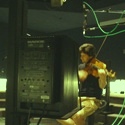Research
St. Lawrence String Quartet/Quintet Experiments

Live music experiments have been made with the help of the St. Lawrence String Quartet, Stanford University's Ensemble-in-Residence. We present here a test between The Banff Centre, Alberta, Canada and CCRMA, Stanford University (June 2006) of a split string quintet. The quartet, located at Banff, was extended by a viola player performing from CCRMA. The sound was configured in such a way that only the room acoustics of the hall at Banff were heard. In order to achieve this effect, the viola player was placed in CCRMA's semi-anechoic room. Four speakers were positioned simulating the physical locations of the other members of the quintet (violin 1, violin 2, viola 1, violoncello) surrounding the viola performer. Each instrument in Banff was picked up using a directional microphone that was fed into the individual speakers in the semi-anechoic room, forming the quintet on the Stanford side. Two extra microphones where used to capture the acoustics of the hall. A microphone on the viola player at Stanford was sent to a speaker at Banff, forming the quintet on that side.
During this test, the audio RTT was approx. 50 ms. Neglecting any asymmetries, the performers where separated by a path of approx. 25 ms (unidirectional). They performed Mozart's String Quintet in G minor, K. 516.
Reactions to the delay
NOTE: All the audio files were recorded at Banff.
Qualitative analysis of the performance, recordings and comments from the musicians are illustrative of issues that surface in such circumstances.
During a section between the viola (Stanford) and the violoncello (Banff) which constituted a rhythmic unison, the performance naturally slowed down [MP3]. This effect can be predicted from the present study. Interestingly though, when used consciously by the musicians, it led to what was called the perfect ritard. The effect of “viola waits for cello” and “cello waits for viola” led to this controlled ritard, down to a certain point where the tempo stabilized [MP3]. The amount of delay and the fact that this part of the performance included only two instruments (i.e., in “power” equilibrium) can explain this phenomenon. The musicians were also able to maintain tempo when done consciously, i.e., when they were aware of the delay effect, they could define strategies to be able to play on time (without ritard) [MP3]. Strategies used are consistent with ones discussed earlier and in (Bartlette, C. ,Headlam, D., Bocko, M. & Velikic, G. Effect of network latency on interactive musical performance. Music Perception 24, 49). Again, these effects where observed when there was an equal balance in “ensemble power” (only two musicians performing).
Another interesting effect observed dealt with the opposite situation; an unbalanced power between the two groups. Since four musicians were at Banff but only one at Stanford, the natural tendency (or strategy) of the Stanford viola player was to just follow the quintet. The quartet at Banff had to compensate and “struggle” with the slightly delayed sound coming in from Stanford. This struggle was clearly heard during the test; at one moment, the performers in Banff asked to “turn off” the viola (speaker) coming from Stanford. In that case, what was heard at Stanford was an impeccable performance. This is a real-time case of music minus one [MP3].
Other Methods of Coping with Internet Delay
A conductor, a metronome or self-delay can be added to the ensemble to aid synchronization. Each presents certain difficulties. In principle, visual conducting works because the speed of light is much faster than the speed of sound so that visual cues arrive earlier. However, network-based ensembles find the situation is reversed: sounds arrive ahead of conducted cues (due to significant video acquisition/display and compression delays in present systems). Another possible solution is to lock to a metronome pulse via headphones. But the musical result is mechanical and many ensembles are uncomfortable with playing to click tracks. The rigid tempo precludes expressive timings which are a fundamental quality of their music. Self-delay is the addition of short electronic delay to one's own sound, adjusting it to be synchronized to late arriving (network delayed) sounds from the remote partner. This solution can also be an encumbrance, because for many musicians it creates a different relationship to the sound of their own instrument (much like the church organ scenario, where organists have to play ahead of what they hear since the organ pipes are far from the keyboard).

